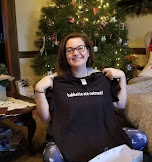The T-Shirts I Have Made
& Tips, Tricks, Tutorials & Free SVGS For Making Your Own
& Tips, Tricks, Tutorials & Free SVGS For Making Your Own
For at least a few years after getting my first cricut, I made shirts every week. In those days, I never cut paper- I was busy putting vinyl and htv on everything. Every. Thing. LOL! I've made hundreds of t-shirts over the years, with my cricut. And I don't sell them. We just have a huge family, and my husband really loves T-shirts.
My favorite place to get the shirts is, of all places,
Wal-Mart
They get good plain t-shirts, very soft, in for $3-$5 every once in awhile, and they are my absolute favorite. Otherwise I make due with what I can find at Michaels and Hobby Lobby. I wish I could find a good way to order online, but since I do not make items to sell, it's never been
Tips For Using HTV:
Remember, for HTV you place the HTV Shiny side down on the mat
And you Reverse, or Mirror the design. You're cutting on the BACK of the material. Once weeded, you'll flip the design onto the fabric, and iron [or heat press] it on.
==============================
Here are some of the ones I have made.
When possible, links below the photos have the free svg and/or instructions.
When possible, links below the photos have the free svg and/or instructions.
|
|
WITH FREE SVGS |
|
|
|
When I was doing the Couch To 5k Running program a few ears back, this was my favorite t-shirt. Unfortunately, the site that had the svg is long gone.. but this wouldn't be too hard to recreate!
|
|
|
|
Babbette Ate Oatmeal (I don't remember which font I used - a plain one!) |
|
|
|
|
I don't remember where the svg for this one came from... maybe Hellosvg? |
|
RED Friday [Remember Everyone Deployed] |
|
|
|
|
|
|
If I had to guess, I'd say that svg came from LoveSVG - YEARS ago. |
|
|
|
One of the VERY first shirts I made for my oldest grandson. NO idea where the svg is from. |
I should have made the tractor tires black... again, one of the very first shirts I made. |
|
Shirt For the 2019 |
 |
|
|
|
More Geocaching Shirts... |
A quick shirt for one of the grandkids... |
===============================
==================================================
MORE shirts I have made:
Just a variety of shirts I made one day...
Welcome Home Shirts for my grandsons, one of whom was born while his Daddy was deployed.
Another mixture of Shirts... and a couple of other htv items.
============================
The Origins Of The T-Shirt
===========================
"The origins of the t-shirt date back to the late 19th century, when laborers would cut their jumpsuits in half to keep cool in warmer months of the year.
The first manufactured t-shirt was invented between the Spanish-American War in 1898, and 1913 when the U.S. Navy began issuing them as standard undershirts.
Even then, it took until 1920 for the actual term “t-shirt” to be inducted into the English dictionary, thanks to F. Scott Fitzgerald being the first person to publish the word in his novel This Side of Paradise.
“So early in September Amory,” writes Fitzgerald, “provided with ‘six suits summer underwear, six suits winter underwear, one sweater or T-shirt, one jersey, one overcoat, winter, etc,’ set out for New England, the land of schools.”
Though the t-shirt was created in the early 20th century, it was rare to see it worn as anything other than an undershirt. It wasn’t uncommon to see veterans wearing a t-shirt tucked into their trousers post-World War II, but outside of that, t-shirts were almost exclusively used underneath “proper” clothes.
Then came Marlon Brando and James Dean.
In 1950, Marlon Brando famously donned a white t-shirt as Stanley Kowalski in A Streetcar Named Desire, only to be followed by James Dean in 1955's Rebel Without a Cause. Thanks to these two founding fathers, the popularity of the t-shirt as a stand-alone outerwear garment skyrocketed.
Not only was the t-shirt as an outer-garment becoming acceptable, but it was also being associated with a movement of rebellion.
“It was rebellious, because T-shirts were actually undergarments … It was a tough political statement,” says Dennis Nothdruft, curator of the exhibition titled T-shirt: Cult — Culture — Subversion, which showcased the radical history of the t-shirt at the Fashion and Textile Museum in London last year.
By the time the 1950s rolled around, a number of companies in Miami, Florida began experimenting with garment decoration, but the field was still far from what would later turn into a multi-billion dollar industry of t-shirt printing.
Thomas E. Dewey, a Republican presidential candidate, created what was perhaps the first ever slogan t-shirt with his “Do it with Dewey” campaign, but outside of that, there were not many instances of embellished t-shirts.
Later in the 1950s though, one of the aforementioned printing companies, known then by the name Tropix Togs, held the original license to print Walt Disney characters. Around this time people began to realize the profit that was to be made in graphic t-shirts, and in the 1960s, innovations to the print field, including the birth of screen printing, would help turn the t-shirt industry into what it is today.
Though graphic t-shirts and t-shirt printing began in the 1950s and 1960s, it wasn’t until the ’70s that t-shirts became the powerful messaging platform that we know them as today. For this, we can thank the punk movement.
Rising popularity in rock band logos, along with protests of the Vietnam War, really helped solidify the t-shirt as a messaging platform. It was “about shocking and outraging people and challenging the status quo,” says Nothdruft.
The New York Times perhaps said it best, when the rise of the graphic t-shirt lead them to name it “the medium for the message.”






.png)














.jpg)






















No comments:
Post a Comment